

 “sans” – does it make sense?
“sans” – does it make sense?
There is a new trend, still a bit discreet. But it will perhaps – probably – increase. We see it in France and it probably exists in other wine countries as well. I’m talking about the “without sulphur” trend, sans sulfites ajoutés. Or rather, “without added sulphur”. This is nothing new, you may think. But it’s not about natural wines. Not even about organic wines. It is about satisfying consumers who want to avoid sulphur. That’s it.
The way in which the wine has been made is of lesser interest. It is not about avoiding additives (except sulphur) or various processing aids. On the contrary, in order to make these wines – which are often quite cheap and unpretentious – stable without sulphur, other additives or techniques are used e.g. flash pasteurisation. There are for example volume producers such as Gérard Bertrand, the Vignerons de Buzet cooperative and Cellier des Dauphins, among others, who have so far launched wines without added sulphur. Sometimes the wines are organically certified, sometimes not. It is often reliable wines, of good quality in their (relatively low) price range.
As I said, the trend will certainly continue. The more wines that boast “no sulphur” on the label, the more consumers will question the use of sulphur. But if you then replace sulphur with something else? Is it better or worse? And is sulphur really that bad?
The wine tour season starts
Soon we will leave for this year’s first wine tour, which will take us down to Argentina and Chile. It is quite nice to get away from the winter a little, although this year in Paris winter has mainly given us rain, rain, and more rain. The Seine is 5 meters above its normal level. So now is a good time to go find some sun and warm weather. First in Chile-Argentina and then to South Africa. Come with us some time!
Britt & Per
PS: Recommend to your friends to read the Brief !
– – – – –
What’s on at BKWine Tours
Winter 2018
- Chile and Argentina, January 27 – February 11 (full)
- South Africa, February 23 – March 5 (full)
Spring 2018
- Bordeaux, April 25-29
Autumn 2018
- Champagne, September 26-30
- Bordeaux, October 10-14
- Douro Valley in Portugal, October 17-21
- South Africa, November 9-19
Winter 2019
- Chile-Argentina, Jan-Feb
- New Zealand, March
For more information please contact us on email or on phone (we’re on French time), or go to our wine travel site on www.bkwinetours.com!
We also make custom designed wine tours – on-demand tours for you and a group of friends, for your company (maybe to scout new winegrowers?), for a special event… We can combine winery visits and wine touring with other activities: gastronomic workshops, visit to an oyster farm, truffles hunting, cheese making, and more. More info on the custom designed and bespoke BKWine wine tours and travel here!
Read our book(s)
We have written several wine books, nine at the last count. One of them has been translated to English; the others are (so far) only available in Swedish. This is the one that is available in English: Biodynamic, Organic and Natural Winemaking, Sustainable Viticulture and Viniculture
All our books are on wine, but on different subjects: wines of the Languedoc, wine growing and wine making, the wines of France, Tuscany, Bordeaux, Piedmont, Burgundy, Champagne. Several have won prestigeous prizes and awards. Read more on our wine books.
From the World of Wine
In Brief
In short, news and stuff from the world of wine.
New Zealand aims to be leader in low-alcohol wines
The trend has been there for several years now. Demand for wines with lower alcoholic strength increases. However, it is not that easy to make low-alcohol wines. The simplest method, to stop the fermentation at an early stage, is of course not applicable. It would mean residual sugar in the wine. You can use techniques like spinning cone or reverse osmosis, which simply removes a few percent of alcohol from the finished wine. Now New Zealand has announced that it planning to become a leader in this sector. In a slightly different way.
There will be no de-alcoholisation for New Zealand. The low alcohol will come naturally, for example, by the way of working in the vineyard and the selection of yeast varieties. They will use grape varieties that give ripe grapes with lower sugar levels. research work is under way. Already today, Sauvignon Blanc wines with 10% alcohol are popular in New Zealand. But don’t worry; this will only be a part of their production. Read more nzwine.com
Want to know more about New Zealand wines? (Not necessarily low-alcohol ones.) We will soon launch the program for a new New Zealand wine tour scheduled for March 2019. Contact us now for info.
The wine as best supporting actor in French movies
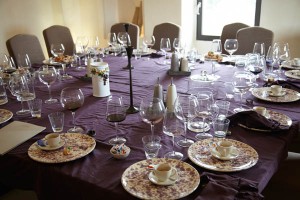 They drink a lot of wine in French movies. We already knew that. But now it is also proven in a research report that has gone through 47 French success films that were released between 1970 and 2014. On average, a wine glass or a bottle of wine appear every twenty minutes in the movies. They also eat a lot in the movies, which, of course, makes it natural to drink wine.
They drink a lot of wine in French movies. We already knew that. But now it is also proven in a research report that has gone through 47 French success films that were released between 1970 and 2014. On average, a wine glass or a bottle of wine appear every twenty minutes in the movies. They also eat a lot in the movies, which, of course, makes it natural to drink wine.
Red wines is served for family dinners, rosé wine is drunk on the beach and in Provence, champagne in restaurants, especially when someone is to be seduced. Men drink red and ladies drink white. Stereotype or a reflection of the truth? Read more: vitisphere.com
Any good French films featuring wine to recommend? Contact us!
Winter pruning. But what to do with all branches?
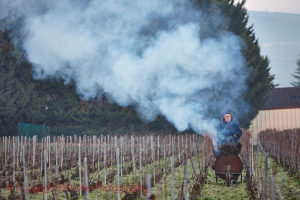 During the winter pruning many tons of vine branches, more specifically about two tons per hectare, are cut off the vines every winter in France. Sarments as it is called in French. In some regions it is a tradition to burn the branches, in others to leave them in the vineyard as a kind of fertilizer. A new research report shows that it is even better than previously thought to use the branches as a fertilizer. The branches will decompose and mineralize and provide good nutrition to the soil. Esca (a dangerous fungus disease) in the vineyard is no problem in this case because the young branches hardly carry any infection, according to the researchers.
During the winter pruning many tons of vine branches, more specifically about two tons per hectare, are cut off the vines every winter in France. Sarments as it is called in French. In some regions it is a tradition to burn the branches, in others to leave them in the vineyard as a kind of fertilizer. A new research report shows that it is even better than previously thought to use the branches as a fertilizer. The branches will decompose and mineralize and provide good nutrition to the soil. Esca (a dangerous fungus disease) in the vineyard is no problem in this case because the young branches hardly carry any infection, according to the researchers.
Perhaps this is good news for many wine growers. To burn the branches is sometimes no longer an option. Last winter, the authorities banned wine growers throughout Burgundy to burn branches due to unusually high pollution in the air. Sarments is also very popular to use when grilling meat. Hope that will not be outlawed. Read more mon-viti.com
Marque & Coop: cooperative with quality ambitions
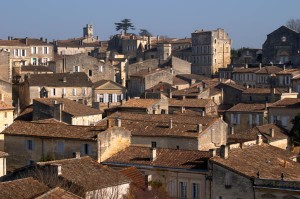 In today’s tough competition, all wine producers must make every effort to keep customers and to win new ones. Not least is it important for the cooperatives. These are important for the French wine industry – they account for 50% of total production – but they have not had the best of reputations.
In today’s tough competition, all wine producers must make every effort to keep customers and to win new ones. Not least is it important for the cooperatives. These are important for the French wine industry – they account for 50% of total production – but they have not had the best of reputations.
“Together, we are strong” could be the motto for Marques & Coop, an association of 12 French cooperatives with the ambition to offer good quality and affordable wines within their respective appellations. Together they represent 4000 growers and 30,000 hectares. They have set their own strict rules. “In our cellars, many talented winemakers start their career,” said Jacques Tranier from Vinovalie.
Members are: Celliers des Prince, the only cooperataive in Châteauneuf-du-Pape, Chassenay d’Arce i Côte des Bar in southern Champagne, Estandon Vignerons in Provence, Loire Propriétés, Ortas Cave de Rasteau in southern Rhône Valley, Sieur d’Arques in Limoux, Les Vignerons de Tutiac in Bordeaux, Agamy in the area around Lyon, UDP Saint Emilion in Bordeaux, Union des Vignerons de l’Île de Beauté in Corsica, Vignerons Ardéchois in southern Rhône Valley and Vinovalie in the Southwest. Coops with ambition!
Amarone Families changes their name
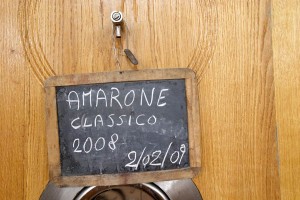 Name can be a sensitive matter. Famiglie Dell’Amarone d’Arte, or Amarone Families, as it is commonly known in English, is an association founded in 2009, consisting of 13 family wineries in Valpolicella. The association wants to preserve Amarone as an exclusive and high-quality wine, with no compromising on quality. So far everything is fine. But other producers in Valpolicella can of course have the same objective without being members of the association. And these do not like the fact that the Amarone families have “seized” the name Amarone. Now, according to Wine Spectator, the Amarone families have been ordered by a judge to rename their association.
Name can be a sensitive matter. Famiglie Dell’Amarone d’Arte, or Amarone Families, as it is commonly known in English, is an association founded in 2009, consisting of 13 family wineries in Valpolicella. The association wants to preserve Amarone as an exclusive and high-quality wine, with no compromising on quality. So far everything is fine. But other producers in Valpolicella can of course have the same objective without being members of the association. And these do not like the fact that the Amarone families have “seized” the name Amarone. Now, according to Wine Spectator, the Amarone families have been ordered by a judge to rename their association.
The name, if one visits the association’s website, is now Le Famiglie Storiche, the historical families. So the name change has probably already happened. Well known families in the association are Allegrini, Masi, Musella, Speri, Tedeschi, Tenuta Tommasi and Zenato. Brand protection is very important in the world of wine today! Read more winespectator.com
Restaurant Natur in Gothenburg
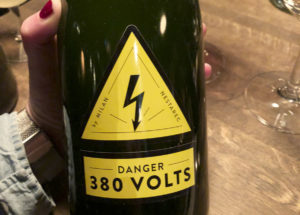 We are constantly looking for natural wine bars in Paris (our masochistic streak?). But you can find them in other places as well. For example in Gothenburg on the Swedish west coast. Several restaurants and bars there now have natural wines on the wine list. One of the best is Natur on the Geijer Street. The selection is impressive. The staff is knowledgeable and you are well advised to consult with them before ordering their wine, especially since most of the names on their list are not very well-known. Without advice, we would probably not have chosen a Czech wine called Danger 380 Volts made with muller thurgau, muscat and Neuberger grapes. The wine was very natural in style, a bit like cider, a bit cloudy… but really good. The producer is Milan Nestarec. The food is good, quite ambitious without being overworked. Starters between 145 and 160 SEK, main courses 240-260 SEK or a 3 course menu for 400 kronor. Attentive service. More on them: restaurangnatur.se
We are constantly looking for natural wine bars in Paris (our masochistic streak?). But you can find them in other places as well. For example in Gothenburg on the Swedish west coast. Several restaurants and bars there now have natural wines on the wine list. One of the best is Natur on the Geijer Street. The selection is impressive. The staff is knowledgeable and you are well advised to consult with them before ordering their wine, especially since most of the names on their list are not very well-known. Without advice, we would probably not have chosen a Czech wine called Danger 380 Volts made with muller thurgau, muscat and Neuberger grapes. The wine was very natural in style, a bit like cider, a bit cloudy… but really good. The producer is Milan Nestarec. The food is good, quite ambitious without being overworked. Starters between 145 and 160 SEK, main courses 240-260 SEK or a 3 course menu for 400 kronor. Attentive service. More on them: restaurangnatur.se
Famous chef Paul Bocuse dies
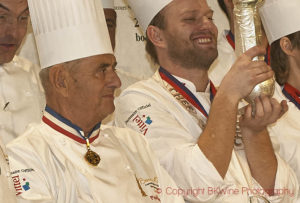 Paul Bocuse, France’s most famous chef, died 91 years old on January 20. Paul Bocuse was the leading and emblematic figure of the new French gastronomy, but at the same time he was very attached to French culinary traditions. He received his first Michelin star in 1958 at the family restaurant Auberge du Pont de Collonges five kilometres north of Lyon. Two years later, he obtained his second star and in 1966 his third, which he held on to ever since. 52 years with three stars!
Paul Bocuse, France’s most famous chef, died 91 years old on January 20. Paul Bocuse was the leading and emblematic figure of the new French gastronomy, but at the same time he was very attached to French culinary traditions. He received his first Michelin star in 1958 at the family restaurant Auberge du Pont de Collonges five kilometres north of Lyon. Two years later, he obtained his second star and in 1966 his third, which he held on to ever since. 52 years with three stars!
Bocuse became a legend during his lifetime and he will hardly be forgotten. Chefs all over the world will continue to be inspired by him. His gastronomic restaurant and all his other restaurants around the world will remain, as will all his books and the prestigious competition Bocuse d’Or, the “world championship for chefs”. His motto was: “Classique ou modern, il n’y a qu’une seule cuisine… la bonne.” More on Bocuse: bocuse.fr
8 things to look at when choosing travel company for a wine tour
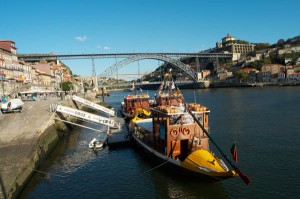 To choose which tour operator to travel with is a bit like getting married. You don’t really know what kind of experience it will be until after you have made the decision. The only way to really know is to have travelled with someone previously (a tactic that is a bit more difficult, but not entirely impossible, for marriage). That’s why we are particularly proud of having so many travellers who come back and come back. I am not sure what the record is but it is more than eight tours with us.
To choose which tour operator to travel with is a bit like getting married. You don’t really know what kind of experience it will be until after you have made the decision. The only way to really know is to have travelled with someone previously (a tactic that is a bit more difficult, but not entirely impossible, for marriage). That’s why we are particularly proud of having so many travellers who come back and come back. I am not sure what the record is but it is more than eight tours with us.
We have put together a small “crib”, a list with things that we thing are important and that one should consider when choosing a tour operator for going on a wine tour. You can read the full list on BKWine’s Travel Blog: How to choose a wine tour operator: 8 things to remember.
Something we forgot?
Wine travellers on wine travelling experiences
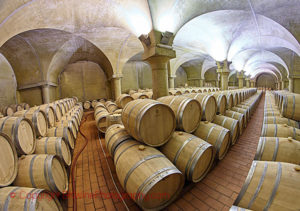 We have collected a few more comments from our travellers on what they have to say about our tours:
We have collected a few more comments from our travellers on what they have to say about our tours:
- “I felt like an important VIP guest!”, said a traveller on a wine tour in Le Marche
- “A total success, what more could one wish for?”, said those who travelled on a wine tour in South Africa with BKWine
- “You surpassed our high expectations“, what travellers think of the wine tour Three Classics, Champagne, Chablis, Burgundy
Read more comments from travellers here. We have a new wine tour to South Africa coming up in November.
What are the “normal” for tipping, taxis, restaurants, and more in the country where you are going?
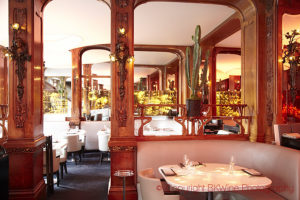 It is often difficult to know a many of the “practical” things when travelling to a new country. For example, what is the common practice for giving tips (e.g. if one does not tip at least 10% in a restaurant in the US one risks being told off rather rudely)? What about taxi? Can you drink the tap water? What time is dinner? And much more. We have put together some “FAQs” about countries that are interesting destinations for a wine tour, that you might find useful if you travel with us or if you travel by yourself:
It is often difficult to know a many of the “practical” things when travelling to a new country. For example, what is the common practice for giving tips (e.g. if one does not tip at least 10% in a restaurant in the US one risks being told off rather rudely)? What about taxi? Can you drink the tap water? What time is dinner? And much more. We have put together some “FAQs” about countries that are interesting destinations for a wine tour, that you might find useful if you travel with us or if you travel by yourself:
- France FAQ: Handy tips on tipping customs, shopping hours, restaurant etiquette, transport and more
- Chile FAQ: on tipping, transport, restaurants, currency, telecom etc
- Chile’s food: A quick introduction
- Argentina FAQ: on tipping, transport, restaurants, currency, telecom etc
More countries are coming! If you have comments, or perhaps you think we’ve got it wrong, please give us feedback! (It’s so much South America because we’re going there soon.)
City guides in France and Argentina
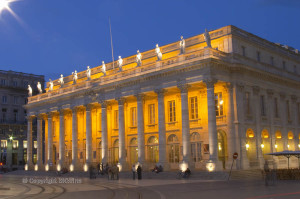 We have also put together a few short city guides, which give you an introduction to some important cities in the wine world. First out are France and Argentina. They give you a little bit of a taste of the cities and maybe some tips on what to do when you’re out on a wine tour (or travelling for some other reason).
We have also put together a few short city guides, which give you an introduction to some important cities in the wine world. First out are France and Argentina. They give you a little bit of a taste of the cities and maybe some tips on what to do when you’re out on a wine tour (or travelling for some other reason).
And, of course, we are grateful for comments, and if you have more recommendations about your favourites!
- Bordeaux City Guide
- Beaune City Guide
- Saint Emilion, a short city guide
- Buenos Aires, a short introduction to the city
- Mendoza: What to see and do, and where to eat | a quick introduction
Features
Features that we have published during the past month, with lots of reading for you.
There is a Tokaji to suit every taste
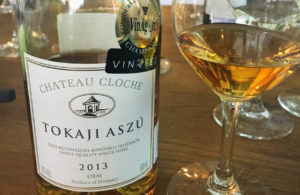 “Chateau Cloche is located in the town of Szerencs in the Hungarian wine district of Tokaj-Hegyalja in the north-eastern part of Hungary where the Zemplénberg slopes down towards the plain where the rivers Bodrog and Tisza rush forward. The chateau has 2 vineyards, Betsek, Makkos and Harcsa, at altitudes between 150 meters and 450 meters above sea level. Could it be that Tokaji is more than “just” sweet botrytis with points (puttonyos)? After a tasting of a number of Chateau Cloche’s products, I can say that the answer to that question is YES!
“Chateau Cloche is located in the town of Szerencs in the Hungarian wine district of Tokaj-Hegyalja in the north-eastern part of Hungary where the Zemplénberg slopes down towards the plain where the rivers Bodrog and Tisza rush forward. The chateau has 2 vineyards, Betsek, Makkos and Harcsa, at altitudes between 150 meters and 450 meters above sea level. Could it be that Tokaji is more than “just” sweet botrytis with points (puttonyos)? After a tasting of a number of Chateau Cloche’s products, I can say that the answer to that question is YES!
BKWine Magazine’s reporter Henrik Stadler reports from an exciting Hungarian tasting: There is a Tokaji to suit every taste.
The Sicilian grape grillo on the stage, Il Fondo Antico wines prize
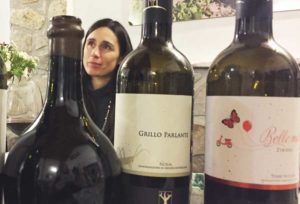 Lorenza Scianna is a winemaker at the wine producer Il Fondo Antico in western Sicily, not far from Marsala. She was one of the first to believe in the characteristics of the grape grillo and since 2002 she makes a wine with a hundred percent grillo called Grillo Parlante (the talking grasshopper). At the end of November, Grillo Parlante won the price for the best white wine in southern Italy at the Radici del Sud wine competition where BKWine Magazine´s Åsa Johansson sat in the jury.
Lorenza Scianna is a winemaker at the wine producer Il Fondo Antico in western Sicily, not far from Marsala. She was one of the first to believe in the characteristics of the grape grillo and since 2002 she makes a wine with a hundred percent grillo called Grillo Parlante (the talking grasshopper). At the end of November, Grillo Parlante won the price for the best white wine in southern Italy at the Radici del Sud wine competition where BKWine Magazine´s Åsa Johansson sat in the jury.
Read Åsa’s interview with the winemaker on BKWine Magazine: Grillo Parlante wins the award as southern Italy’s best white wine.
We also do wine tours to Sicily.
Our pretty winner’s award certificate for the Champagne book
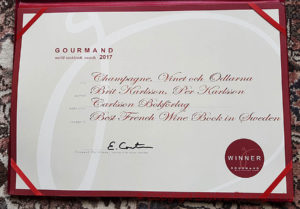 You will have heard it (more than enough?) by now: our Champagne book, Champagne, the Wine and the Growers, was awarded the prize as “the best wine book on France” by the Gourmand Awards in Sweden. We have just received our very pretty certificate as winner in that category. It came in a very posh presentation folder with Chinese writing on the front. I guess that has to do with that the international finals of the Gourmand Awards will take place in China, and has taken place there at a few previous occasions.
You will have heard it (more than enough?) by now: our Champagne book, Champagne, the Wine and the Growers, was awarded the prize as “the best wine book on France” by the Gourmand Awards in Sweden. We have just received our very pretty certificate as winner in that category. It came in a very posh presentation folder with Chinese writing on the front. I guess that has to do with that the international finals of the Gourmand Awards will take place in China, and has taken place there at a few previous occasions.
You can see how it looks on BKWine Magazine: Our pretty winner’s award certificate for the Champagne book.
Come on a wine tour to Champagne with us; you can hardly find anyone better to take you round to the producers.
Cook Magazine (Belgium) on our Organic Wine Book
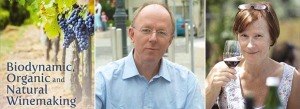 Cook Magazine is a very beautiful glossy magazine for restaurants, chefs, and hotels in Belgium. As many publications in Belgium, it is bilingual and publishes everything in two languages. In their most recent issue, they have a whole page dedicated to a presentation of our book on organic wines: Biodynamic, Organic, and Natural Winemaking.
Cook Magazine is a very beautiful glossy magazine for restaurants, chefs, and hotels in Belgium. As many publications in Belgium, it is bilingual and publishes everything in two languages. In their most recent issue, they have a whole page dedicated to a presentation of our book on organic wines: Biodynamic, Organic, and Natural Winemaking.
Read more on Cook Magazine and the book on BKWine Magazine: Cook Magazine (Belgium) on our Organic Wine Book.
A great day for Austrian wines
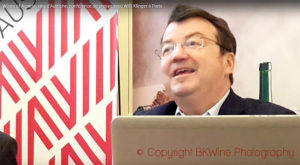 It is not every day one can enjoy a wealth of Austrian wines in Paris. It’s a pity. I’ve been to Austria several times and the wines I have tasted are fantastic. Outstanding whites and reds that are not so well know, from not so well-known indigenous varieties, that are also making great headway. And also luscious sweet ones. But what I personally like the best are the very fresh, stringent, mineral vibrating dry whites, grüner veltliner of course but also riesling and others. Recently there was an Austrian Wine Day in Paris though.
It is not every day one can enjoy a wealth of Austrian wines in Paris. It’s a pity. I’ve been to Austria several times and the wines I have tasted are fantastic. Outstanding whites and reds that are not so well know, from not so well-known indigenous varieties, that are also making great headway. And also luscious sweet ones. But what I personally like the best are the very fresh, stringent, mineral vibrating dry whites, grüner veltliner of course but also riesling and others. Recently there was an Austrian Wine Day in Paris though.
Watch the press conference video and several video interviews with Austrian winemakers on BKWine Magazine: A great day for Austrian wines.
The world’s most grown grape variety is not what you think! The top-ten list | Britt on Forbes
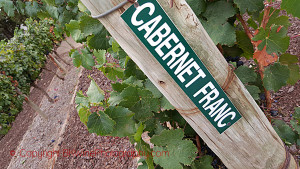 Chardonnay? Cabernet? Syrah? Or if you have done your homework (some while ago), airen? No, no, no, and no. But one might say that it is (to some extent) a trick question. The world’s most grown grape variety is not used to make wine. It is a Chinese grape variety. The second most grown variety is used for raisins. So, if we restrict the question to grapes used for making wine, then one of the four mentioned above is in fact the one with the biggest acreage. Statistics from OIV, The International Organisation of Vine and Wine, give us all the answers.
Chardonnay? Cabernet? Syrah? Or if you have done your homework (some while ago), airen? No, no, no, and no. But one might say that it is (to some extent) a trick question. The world’s most grown grape variety is not used to make wine. It is a Chinese grape variety. The second most grown variety is used for raisins. So, if we restrict the question to grapes used for making wine, then one of the four mentioned above is in fact the one with the biggest acreage. Statistics from OIV, The International Organisation of Vine and Wine, give us all the answers.
Read more on the most planted grapes in Britt’s article on BKWine Magazine, originally published on Forbes: The Top Ten Grape Varieties In The World.
Oldenburg in Stellenbosch putting on a show with a celebrity TV chef
I discovered by chance some time ago that Oldenburg Vineyards had made a video about us. Oldenburg Vineyards is a wine producer in Stellenbosch in South Africa. They have their winery and vineyards in an incredible place, spectacularly at the end of a dirt road, surrounded by tall mountain peaks. We had a cellar visits, tasting and lunch there together with the wine maker on our latest wine tour in South Africa. The lunch was prepared by what might be called celebrity chef in South Africa, or at least a chef famous from television. A wonderful experience that you can see more about on the video here: BKWine Tours visit Oldenburg Vineyards, Stellenbosch, South Africa.
Wine tours
Some information about current and future wine tours with BKWine.
Bordeaux: 7000 “castles” and lots of vineyards | wine tour
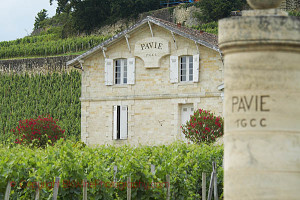 Bordeaux is one of France’s largest wine regions with 112 000 hectares of vineyards. There are about 7000 chateau (“castles”). Everyone does not make their own wine. Some sell their grapes to a negociant or belong to a cooperative. The chateaux exist in all sizes and looks. Some are no more than a regular little villa; others are beautiful Cinderella castle. The oldest are from the 16th century and classified as historical monuments.
Bordeaux is one of France’s largest wine regions with 112 000 hectares of vineyards. There are about 7000 chateau (“castles”). Everyone does not make their own wine. Some sell their grapes to a negociant or belong to a cooperative. The chateaux exist in all sizes and looks. Some are no more than a regular little villa; others are beautiful Cinderella castle. The oldest are from the 16th century and classified as historical monuments.
The most important thing is after all to have a well-equipped cellar. Some have invested in the latest equipment and have expensive grape sorting machines. Some have brand new concrete vats for the fermentation, beautiful as if in an art gallery. Some prefer stainless steel tanks, while others have not seen any need to replace the old concrete tanks from the 1960s. Everyone has a different philosophy. We will see much of all this on our wine tour to Bordeaux in April. And then in the autumn there is a Bordeaux wine tour in October too.
Harvest time in Champagne | wine tour
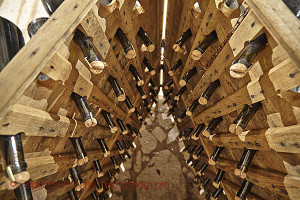 In Champagne in late September the harvest is probably in full swing (but it depends on the weather). There will be a lot of activity in the vineyards and in the cellars. This is an interesting time to visit the wine region and we will get to know some of the secrets of champagne on our wine tour. For example, how to decide that the grapes are ripe enough to be picked. We go out in the vineyard, we look at the soil, we talk about the terroir and also about organic and sustainable wine viticulture.
In Champagne in late September the harvest is probably in full swing (but it depends on the weather). There will be a lot of activity in the vineyards and in the cellars. This is an interesting time to visit the wine region and we will get to know some of the secrets of champagne on our wine tour. For example, how to decide that the grapes are ripe enough to be picked. We go out in the vineyard, we look at the soil, we talk about the terroir and also about organic and sustainable wine viticulture.
We will also discuss the current trend with extra brut and brut nature, that is the very dry Champagnes, and other interesting topics. And taste lots of great wine and food of course. In other words, after the tour, you will know a lot about champagne. And maybe even more important: You will have tried a lot of Champagne! Some of these Champagnes will be drunk during our amazing lunches. Join us on the wine tour to Champagne in September.
(By the way, our latest book, that was on Champagne, has just won prize as the best book on French wines in the Gourmand Awards Sweden.)
Douro Valley: spectacular landscape, local grape varieties | wine tour
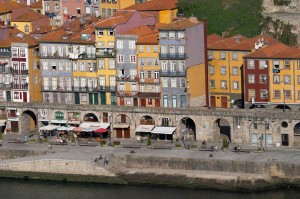 Portugal has its own local grape varieties, few known outside the country. During our tour to the amazing Douro Valley in the northern part of the country we will encounter many of them: touriga national, touriga franca, sousa, tinta roriz and many more. You do find French grape varieties too in Portugal, but they are rare. And we are quite happy with that. The local varieties make Portugal a very interesting wine country. The Portuguese are very keen to preserve the vineyards distinctive character.
Portugal has its own local grape varieties, few known outside the country. During our tour to the amazing Douro Valley in the northern part of the country we will encounter many of them: touriga national, touriga franca, sousa, tinta roriz and many more. You do find French grape varieties too in Portugal, but they are rare. And we are quite happy with that. The local varieties make Portugal a very interesting wine country. The Portuguese are very keen to preserve the vineyards distinctive character.
The Douro Valley is one of the most spectacular wine regions that we know of, with incredibly steep slopes. We will taste both port wines and red and white dry Douro wines. The Douro valley, formerly known as the Valley of Port, has changed. For the better, we think. The dry Douro wines are amazing. But so is a 20 year old tawny. The wine tour to the Dour Valley in Portugal will take place in October.
Perfect wine tour time in November: Spring in South Africa
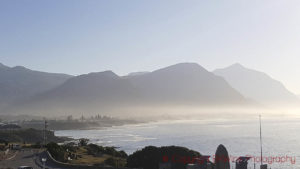 Whales, mountains and wines with personality will feature on the November wine tour when it is is spring in South Africa, so it is a colourful, flourishing landscape that greets us. We meet in Cape Town and continue on to Hermanus on the south coast where we will taste Sauvignon Blanc and Pinot Noir from some high-quality producers. It is the whale season so we are looking forward to going out on a boat for a close encounter with these giants of the sea.
Whales, mountains and wines with personality will feature on the November wine tour when it is is spring in South Africa, so it is a colourful, flourishing landscape that greets us. We meet in Cape Town and continue on to Hermanus on the south coast where we will taste Sauvignon Blanc and Pinot Noir from some high-quality producers. It is the whale season so we are looking forward to going out on a boat for a close encounter with these giants of the sea.
Then we will continue to Franschhoek, Paarl and Stellenbosch. We enjoy the landscape, the mountains, the food and, the most important thing, the wines. Some sightseeing is included, of course, such as the Table Mountain and the Cape of Good Hope. South Africa is magnificent. And you will discover wines with a real personality.
Come and enjoy this wine tour to South Africa with us in November 2018.
For the long term planners: more southern hemisphere | wine tours
We already know that winter 2019 will be cold and dark, so we have planned to fantastic destinations for you to brighten up your winter. The full planning is not yet finishes but here are the destinations and the times. If you are interested, contact us already now and you will be the first to hear about it when it is available:
Chile and Argentina in Jan-Feb 2019, the two leading South American wine countries.
New Zealand, March 2019, a stunningly beautiful country mostly famous for sauvignon blanc and a bit of pinot (for wine) but that has so much more outstanding wine to offer!
Don’t be an egoist! Share with your friends and other wine enthusiasts! Forward the Brief to your friends! Suggest that they sign up for a free subscription !
© Copyright BKWine






